Preparation and Properties of SBR Composites Containing Graphene Nanoplatelets Modified with Pyridinium Derivative
Abstract
1. Introduction
2. Materials and Methods
2.1. Materials
2.2. Preparation of SBR Vulcanizates
2.3. Characterization
3. Results and Discussion
3.1. Textural Properties of Fillers
3.2. Fillers Dispersion
3.3. Thermal Properties of Fillers, BMPFB and SBR Composites
3.4. Cure Charcteristics
3.5. Mechanical Performance
3.6. Electrical Propertiesof SBR Composites
3.7. Gas Barrier Properties
4. Conclusions
Author Contributions
Funding
Acknowledgments
Conflicts of Interest
References
- Zirbstein, B.; Tabaka, W.; Frasca, D.; Schulze, D.; Schartel, B. Graphene/hydrogenated acrylonitrile-butadiene rubber nanocomposites: Dispersion, curing, mechanical reinforcement, multifunctional filler. Polym. Test. 2018, 66, 268–279. [Google Scholar] [CrossRef]
- Antunes, M.; Gedler, G.; Abbasi, H.; Velasco, H.I. Graphene nanoplatelets as a multifunctional filler for polymer foams. Matter. Todays Proceed. 2016, 3S, S233–S239. [Google Scholar] [CrossRef]
- Chen, J.; Li, H.; Yu, Q.; Hu, Y.; Cui, X.; Zhu, Y.; Jiang, W. Strain sensing behaviors of stretchable conductive polymer composites loaded with different dimensional conductive fillers. Compos. Sci. Technol. 2018, 168, 388–396. [Google Scholar] [CrossRef]
- Li, X.; Li, M. Multifunctional self-sensing and ductile cementitious materials. Cem. Con. Res. 2019, 123, 105714. [Google Scholar] [CrossRef]
- Gardner, J.M.; Sauti, G.; Kim, J.-W.; Cano, R.J.; Wincheski, R.A.; Stelter, C.J.; Grimsley, B.W.; Working, D.C.; Siochi, E.J. 3-D printing of multifunctional carbon nanotube yarn reinforced components. Add. Manuf. 2016, 12, 38–44. [Google Scholar] [CrossRef]
- Smith, A.T.; LaChance, A.M.; Zeng, S.; Liu, B.; Sun, L. Synthesis, properties, and applications of graphene oxide/reduced graphene oxide and their nanocomposites. Nano Mater. Sci. 2019, 1, 31–47. [Google Scholar] [CrossRef]
- Tahriri, M.; Del Monico, M.; Moghanian, A.; Yaraki, M.T.; Torres, R.; Yadegari, A.; Tayebi, L. Graphene and its derivatives: Opportunities and challenges in dentistry. Mat. Sci. Eng. C 2019, 102, 171–185. [Google Scholar] [CrossRef]
- Kernin, A.; Wan, K.; Liu, Y.; Shi, X.; Kong, J.; Bilotti, E.; Peijs, T.; Zhang, H. The effect of graphene network formation on the electrical, mechanical, and multifunctional properties of graphene/epoxy nanocomposites. Compos. Sci. Technol. 2019, 169, 224–231. [Google Scholar] [CrossRef]
- Wen, Y.; Yin, Q.; Jia, H.; Yin, B.; Zhang, X.; Liu, P.; Wang, J.; Ji, Q.; Xu, Z. Tailoring rubber-filler interfacial interactions and multifunctional rubber nanocomposites by usage of graphene oxide with different oxidation degrees. Composites B 2017, 124, 250–259. [Google Scholar] [CrossRef]
- Li, Y.; Wang, Q.; Wang, S. A review on enhancement of mechanical and tribological properties of polymer composites reinforced by carbon nanotubes and graphene sheet: Molecular dynamics simulations. Composites B 2019, 160, 348–361. [Google Scholar] [CrossRef]
- Zhong, B.; Dong, H.; Luo, Y.; Zhang, D.; Jia, Z.; Jia, D. Simultaneous reduction and functionalization of grapheme oxide via antioxidant for highly aging resistant and thermal conductive elastomers composites. Comp. Sci. Technol. 2017, 151, 156–163. [Google Scholar] [CrossRef]
- Ljubic, D.; Srinivasan, M.; Szoszkiewicz, R.; Javni, I.; Petrović, Z.S. Surface modified graphene/single-phase polyurethane elastomers with improved thermo-mechanical and dielectric properties. Eur. Polym. J. 2015, 70, 55–65. [Google Scholar] [CrossRef]
- Wang, Z.; Nelsno, J.K.; Hillborg, H.; Zhao, S.; Schadler, L.S. Graphene oxide filled nanocomposite with novel electrical and dielectric properties. Adv. Mater. 2012, 24, 3134–3137. [Google Scholar] [CrossRef]
- Qiu, Y.; Wang, J.; Wu, D.; Wang, Z.; Zhang, M.; Yao, Y.; Wei, N. Thermoplastic polyester elastomer nanocomposites filled with graphene: Mechanical and viscoelastic properties. Comp. Sci. Technol. 2016, 132, 108–115. [Google Scholar] [CrossRef]
- Liu, X.; Kuang, W.; Guo, B. Preparation of rubber/graphene oxide composites with in-situ interfacial design. Polymer 2015, 56, 553–562. [Google Scholar] [CrossRef]
- Song, S.; Zhang, Y. Carbon nanotube/reduced graphene oxide hybrid for simultaneously enhancing the thermal conductivity and mechanical properties of styrene-butadiene rubber. Carbon 2017, 123, 158–167. [Google Scholar] [CrossRef]
- Mondal, S.; Khastgir, D. Elastomer reinforcement by graphene nanoplatelets and synergistic improvements of electrical and mechanical properties of composites by hybrid nano fillers of graphene-carbon black & graphene-MWCNT. Compos. Part A 2017, 102, 154–165. [Google Scholar] [CrossRef]
- Tian, M.; Wei, Z.; Zan, X.; Zhang, L.; Ma, Q.; Ning, N.; Nishi, T. Thermally expanded graphene nanoplates/polydimethylsiloxane composites with high dielectric constant, low dielectric loss and improved actuated strain. Comp. Sci. Technol. 2014, 99, 37–44. [Google Scholar] [CrossRef]
- Bao, R.-Y.; Cao, J.; Liu, Z.-Y.; Yang, W.; Xie, B.-H.; Yang, M.-B. Towards balanced strength and toughness improvement of isotactic polypropylene nanocomposites by surface functionalized graphene oxide. J. Mater. Chem. A 2014, 2, 3190–3199. [Google Scholar] [CrossRef]
- Zhang, G.; Wang, F.; Dai, J.; Huang, Z. Effect of functionalization of graphene nanoplatelets on the mechanical and thermal properties of silicone rubber composites. Materials 2016, 9, 92. [Google Scholar] [CrossRef]
- Lin, Y.; Liu, S.; Peng, J.; Liu, L. The filler-rubber interface and reinforcement in styrene butadiene rubber composites with graphene/silica hybrids: A quantitative correlation with the constrained region. Composites A 2016, 86, 19–30. [Google Scholar] [CrossRef]
- Kotal, M.; Banerjee, S.S.; Bhowmick, A.K. Functionalized graphene with polymer as unique strategy in tailoring the properties of bromobutyl rubber nanocomposites. Polymer 2016, 82, 121–132. [Google Scholar] [CrossRef]
- Li, W.; Yue, Y.Z.; Wang, M.Y.; Li, Q.; Ren, R. Using maleic anhydride functionalized graphene oxide for improving the interfacial properties of carbon fiber/BMI composites. Express Polym. Lett. 2016, 10, 874–882. [Google Scholar] [CrossRef]
- Wang, G.; Wang, J.; Zhou, S.; Wu, S. Enhanced dielectric properties of acrylic resin elastomers based nanocomposites with thermally reduced graphene nanosheets. RSC Adv. 2016, 6, 98440–98448. [Google Scholar] [CrossRef]
- Zhong, B.; Jia, Z.; Dong, H.; Luo, Y.; Jia, D.; Liu, F. One-step approach to reduce and modify graphene oxide via vulcanization accelerator and its application for elastomer reinforcement. Chem. Eng. J. 2017, 317, 51–59. [Google Scholar] [CrossRef]
- Peng, H.; Meng, L.; Niu, L.; Lu, Q. Simultaneous reduction and surface functionalization of graphene oxide by natural cellulose with the assistance of the ionic liquid. J. Phys. Chem. C 2012, 116, 16294–16299. [Google Scholar] [CrossRef]
- Gui, H.; Xu, P.; Hu, Y.; Wang, J.; Yang, X.; Bahader, A.; Ding, Y. Synergistic effect of graphene and an ionic liquid containing phosphonium on the thermal stability and flame retardancy of polylactide. RSC. Adv. 2015, 5, 27814–27822. [Google Scholar] [CrossRef]
- Zhou, J.; Yao, Z.; Zhen, W.; Wei, D.; Li, S. Dielectric and thermal performances of the graphene/bismaleimide/2,2’-diallylbisphenol A composite. Mater. Lett. 2014, 124, 155–157. [Google Scholar] [CrossRef]
- Zhao, W.; Tang, Y.; Xi, T.; Kong, J. Functionalized graphene sheets with poly(ionic liquid)s and high adsorption capacity of anionic dyes. J. Appl. Surf. Sci. 2015, 326, 276–284. [Google Scholar] [CrossRef]
- Xu, P.; Gui, H.; Wang, X.; Hu, Y.; Ding, Y. Improved dielectric properties of nanocomposites based on polyvinylidene fluoride and ionic liquid-functionalized graphene. Comp. Sci. Technol. 2015, 117, 282–288. [Google Scholar] [CrossRef]
- Xu, Y.; Liu, Z.; Zhang, X.; Wang, Y.; Tian, J.; Huang, Y.; Ma, Y.; Zhang, X.; Chen, Y. A graphene hybrid material covalently functionalized with porphyrin: Synthesis and optical limiting property. Adv. Mater. 2009, 21, 1275–1279. [Google Scholar] [CrossRef]
- Zhang, L.; Wu, H.; Wei, M.; Zheng, Z.; Vu, D.D.; Bui, T.T.X.; Huang, X. Preparation, characterization and properties of graphene oxide/urushiol-formaldehyde polymer composite coating. J. Coat. Technol. Res. 2018, 15, 1343–1356. [Google Scholar] [CrossRef]
- Cao, H.; Hu, Y.; Xu, W.; Wang, Y.; Guo, X. Recent progress in the assembly behavior of imidazolium-based ionic liquid surfactants. J. Mol. Liq. 2020, 319, 114354. [Google Scholar] [CrossRef]
- Chen, Y.; Mu, T. Thermal stability of ionic liquids. In Encyclopedia of Ionic Liquids; Zhang, S., Ed.; Springer: Singapore, 2020. [Google Scholar] [CrossRef]
- Maciejewska, M.; Zaborski, M. Thermal analysis and mechanical methods applied to studying properties of SBR compounds containing ionic liquids. Polym. Test. 2017, 61, 349–363. [Google Scholar] [CrossRef]
- Subramaniam, K.; Das, A.; Steinhauser, D.; Kluppel, M.; Heinrich, G. Effect of ionic liquid on dielectric, mechanical and dynamic mechanical properties of multi-walled carbon nanotubes/polychloroprene rubber composites. Eur. Polym. J. 2011, 47, 2234–2243. [Google Scholar] [CrossRef]
- Lei, Y.D.; Tang, Z.H.; Guo, B.C.; Zhu, L.X.; Jia, D.M. Synthesis of novel functional liquid and its application as a modifier in SBR/silica composites. Express Polym. Lett. 2010, 4, 692–703. [Google Scholar] [CrossRef]
- Fontana, J.P.; Camilo, F.C.; Bizeto, M.A.; Faez, R. Evaluation of the role of an ionic liquidas organophilization agent into montmorillonite for NBR rubber composite production. Appl. Clay Sci. 2013, 83, 203–209. [Google Scholar] [CrossRef]
- Marzec, A.; Laskowska, A.; Boiteux, G.; Zaborski, M.; Gain, O.; Serghei, A. Properties of carboxylated nitryle rubber/hydrotalcite composites containing imidazolium ionic liquids. Macromol. Symp. 2014, 341, 7–17. [Google Scholar] [CrossRef]
- Wu, J.; Xing, W.; Huang, G.; Li, H.; Tang, M.; Wu, S.; Liu, Y. Vulcanization kinetics of graphene/natural rubber nanocomposites. Polymer 2013, 54, 3314–3323. [Google Scholar] [CrossRef]
- Maciejewska, M.; Zaborski, M. Ionic liquids as coagents for sulphur vulcanization of butadiene-styrene elastomers filled with carbon black. Polym. Bull. 2018, 75, 4499–4514. [Google Scholar] [CrossRef]
- Behera, P.K.; Mondal, P.; Singha, N. Polyurethane by ionic liquid crosslink; a new class of super shape-memory like polymer. Polym. Chem. 2018, 9, 4205–4217. [Google Scholar] [CrossRef]
- Mikkola, P.; Taukoniitty, J.P.; Karhu, E.; Kordas, H.; Eranen, K.; Warna, J.; Salmi, T. Supported ionic liquid catalysts-from batch to continous operations in preparation of fine chemicals. Catal. Today 2009, 147, 144–148. [Google Scholar]
- Haumann, M.; Dentler, K.; Joni, J.; Riisager, A.; Wasserscheid, P. Continous gas-phase hydroformylation of 1-butene using supported ionic liquid phase (SLIP) catalysts. Adv. Synth. Catal. 2007, 349, 425–431. [Google Scholar] [CrossRef]
- Krainoi, A.; Kummerlowe, C.; Nakaramontri, Y.; Wisunthorn, S.; Vennemann, N.; Pichaiyut, S.; Kiatkamjornwong, S.; Nakason, C. Influence of carbon nanotubeand ionic liquide on properties of natural rubber nanocomposites. Express Polym. Lett. 2019, 31, 327–348. [Google Scholar] [CrossRef]
- Babucci, A.; Akcay, A.; Balci, V.; Uzun, A. Thermal stability limits of imidazolium ionic liquids immobilized on metal-oxides. Langmuir 2015, 31, 9163–9176. [Google Scholar] [CrossRef] [PubMed]
- Fleck, F.; Mowes, M.; Kluppel, M. Influence of ionic liquid on the polimer-filler coupling of carbon Black filled elastomers. Kautsch. Gummi Kunstst. 2016, 4, 49–52. [Google Scholar]
- Le, H.H.; Wießner, S.; Das, A.; Fischer, D.; auf der Landwehr, M.; Do, Q.K.; Stöckelhuber, K.W.; Heinrich, G.; Radusch, H.J. Selective wetting of carbon nanotubes in rubber compounds-Effect of the ionic liquid as dispersing and coupling agent. Eur. Polym. J. 2016, 75, 13–24. [Google Scholar] [CrossRef]
- Brunauer, S.; Emmett, P.H.; Teller, E. Adsorption of Gases in Multimolecular Layers. J. Am. Chem. Soc. 1938, 60, 309–319. [Google Scholar] [CrossRef]
- Rouquerol, J.; Llewellyn, P.; Rouquerol, F. Is the bet equation applicable to microporous adsorbents? Stud. Surf. Sci. Catal. 2007, 160, 49–56. [Google Scholar] [CrossRef]
- Dubinin, M.M.; Astakhov, V.A.; Radushkevich, L.V. Physical Adsorption of Gases and Vapors in Micropores. In Progress and Membrane Science, 2nd ed.; Cadenhead, D.A., Danielli, J.F., Rosenberg, M.D., Eds.; Academic Press: New York, NY, USA, 1975; Volume 9, pp. 1–70. [Google Scholar]
- Ravikovitch, P.I.; Haller, G.L.; Neimark, A.V. Density functional theory model for calculating pore size distributions: Pore structure of nanoporous catalysts. Adv. Colloid Interface Sci. 1998, 76/77, 3671. [Google Scholar] [CrossRef]
- Raef, M.; Razzaghi-Kashani, M. The role of interface in gas barier properties of styrene butadiene rubber-reduced graphene oxide composites. Polymer 2019, 182, 121816. [Google Scholar] [CrossRef]
- Chehrazi, E.; Raef, M.; Noroozi, M.; Panahi-Sarmad, M. A theoretical model for the gas permeation prediction of nanotube-mixed matrix membranes: Unveiling the effect of interfacial layer. J. Membr. Sci. 2019, 570–571, 168–175. [Google Scholar] [CrossRef]
- The, P.L.; Mohd Ishak, Z.A.; Hashim, A.S.; Karger-Kocsis, J.; Ishiaku, U.S. Effects of epoxidized natural rubber as a compatibilizer in melt compounded natural rubber-organoclaynanocomposites. Eur. Polym. J. 2004, 40, 2513–2521. [Google Scholar] [CrossRef]
- Gheller, J., Jr.; de Barros, I.R.; Jacobi, M.M. Aspects of producing hydrogenated nitrile butadiene rubber (HNBR) nanocomposites by melt compounding processing. Plast. Rubb. Comp. 2017, 46, 60–68. [Google Scholar] [CrossRef]
- Hernandez, M.; Bernal, M.; Verdejo, R.; Ezquerra, T.A.; Lopez-Manchado, M.A. Overall performance of natural rubber/graphene nanocomposites. Comp. Sci. Technol. 2012, 73, 40–43. [Google Scholar] [CrossRef]
- Yue, D.; Liu, Y.; Shen, Z.; Zhang, L. Study on preparation and properties of carbon nanotubes/rubber composites. J. Mater. Sci. 2006, 42, 2541–2544. [Google Scholar] [CrossRef]
- Frasca, D.; Schulze, D.; Wachtendorf, V.; Huth, C.; Schartel, B. Multifunctional multilayer graphene/elastomer nanocomposites. Eur. Polym. J. 2015, 71, 99–113. [Google Scholar] [CrossRef]
- Dikland, H.G.; Ruardy, T.; van der Does, L.; Bantjes, A. New coagents in peroxide vulcanization of EPM. Rubb. Chem. Technol. 1993, 66, 693–711. [Google Scholar] [CrossRef]
- Abraham, J.; Thomas, J.; Kalarikkal, N.; George, S.C.; Thomas, S. Static and dynamic mechanical characteristics of ionic liquid modified MWCNT-SBR composites: Theoretical perspectives for the nanoscale reinforcement mechanism. J. Phys. Chem. B 2018, 12, 1525–1536. [Google Scholar] [CrossRef]
- Ilcikova, M.; Mosnacek, J.; Mrlik, M.; Sedlacek, T.; Csomorova, K.; Czanikova, K.; Krupa, I. Influence of surface modification of carbon nanotubes on interactions with polystyrene-b- polyisoprene-b-polystyrene matrix and its photo-actuation properties. Polym. Adv. Technol. 2014, 25, 1293–1300. [Google Scholar] [CrossRef]
- Xu, H.; Gong, L.-X.; Wang, X.; Zhao, L.; Pei, Y.-B.; Wang, G.; Liu, Y.-J.; Wu, L.-B.; Jiang, J.-X.; Tang, L.-C. Influence of processing conditions on dispersion, electrical and mechanical properties of graphene-filled-silicone rubber composites. Compos. Part A 2016, 91, 53–64. [Google Scholar] [CrossRef]
- Kang, H.; Zuo, K.; Wang, Z.; Zhang, L.; Liu, L.; Guo, B. Using a green method to develop graphene oxide/elastomers nanocomposites with combination of high barrier and mechanical performance. Comp. Sci. Technol. 2014, 92, 1–8. [Google Scholar] [CrossRef]
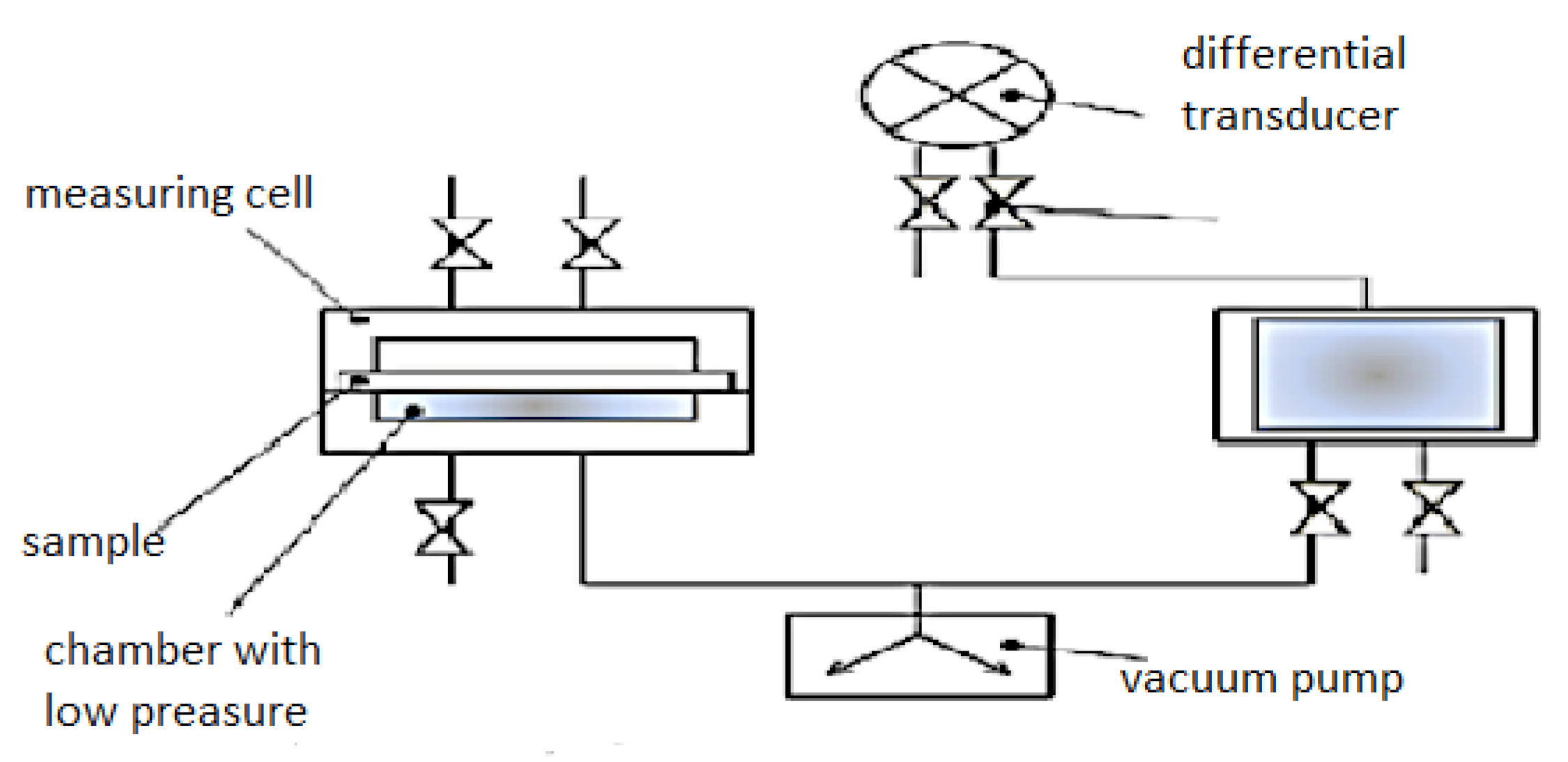
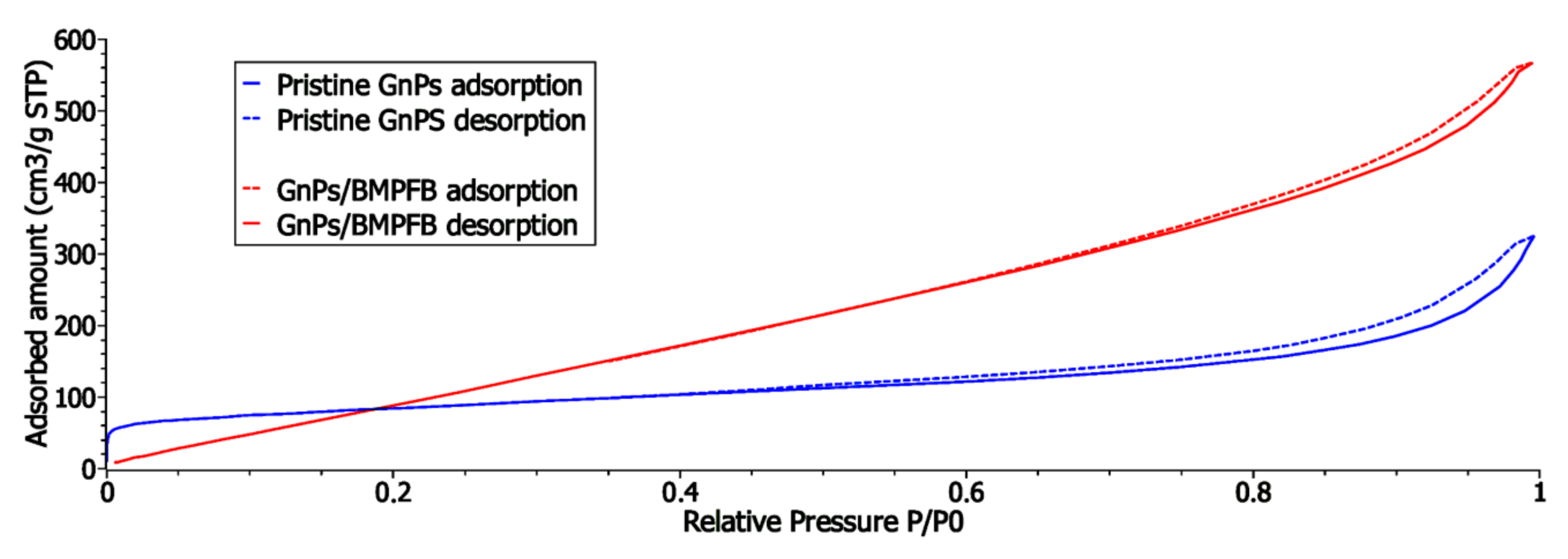
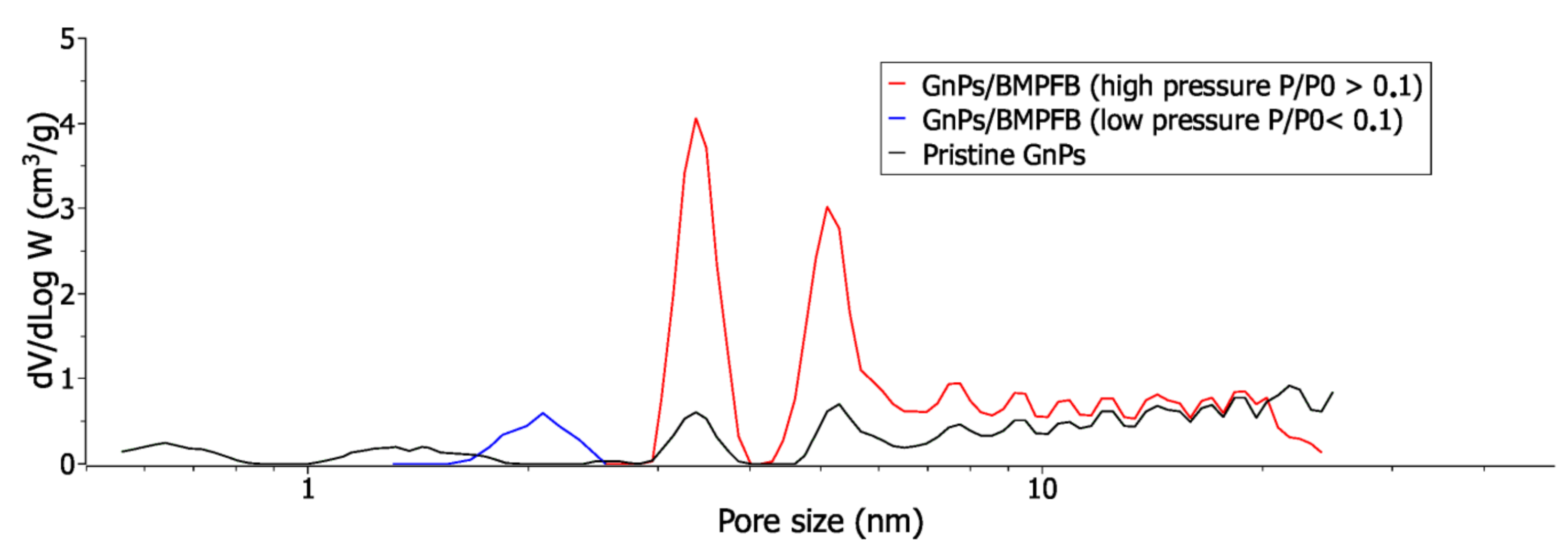
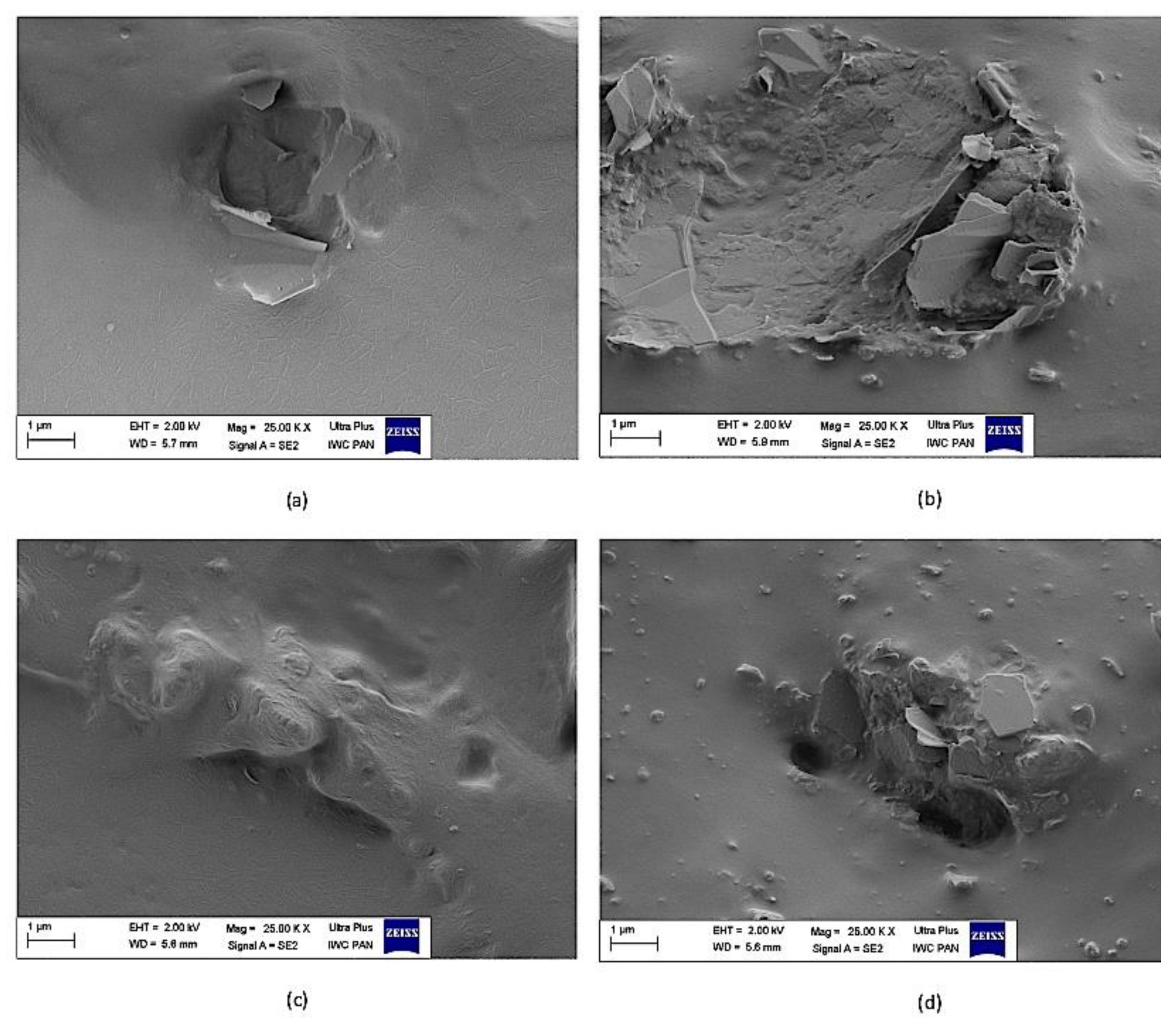
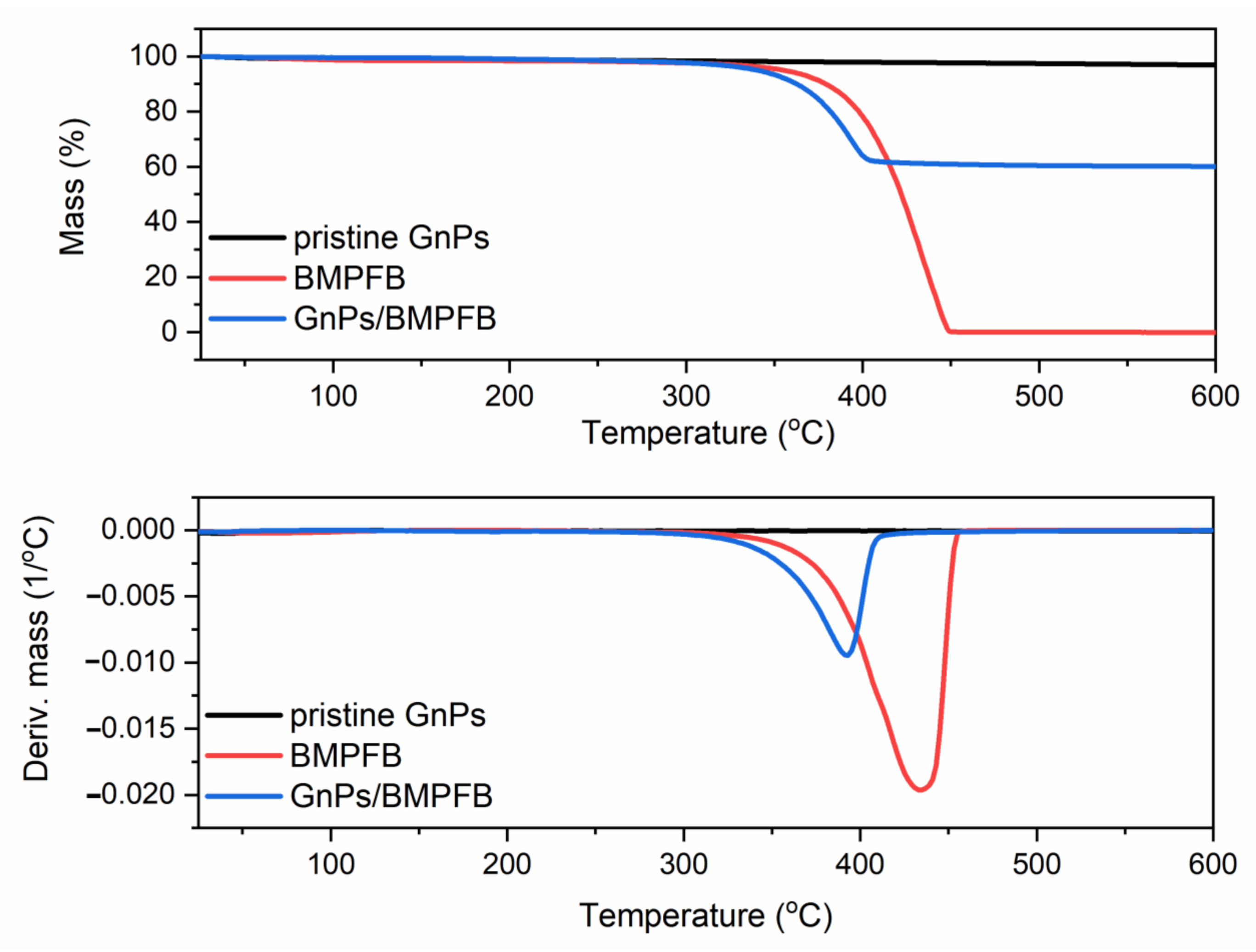
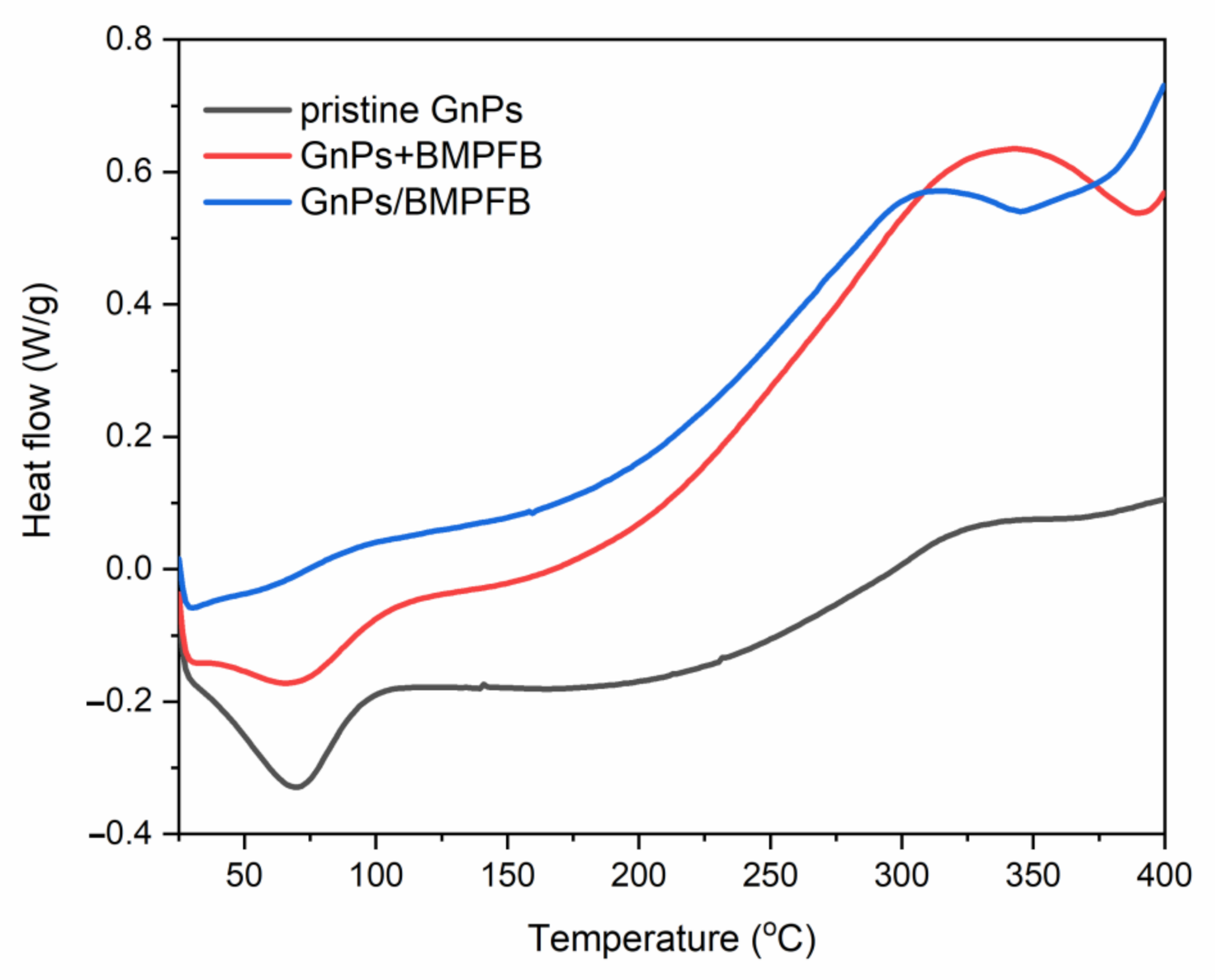
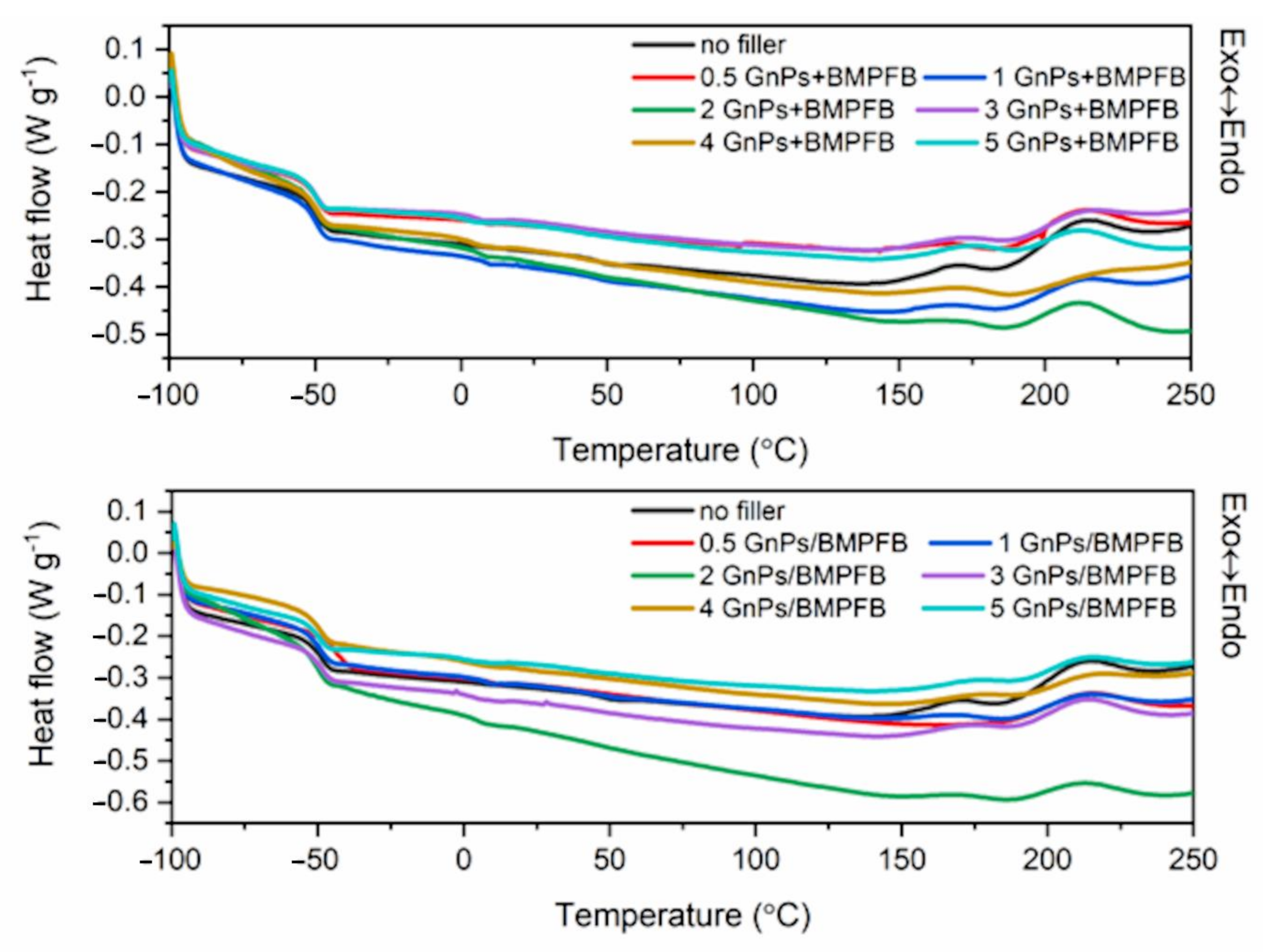

| Material | Symbol of Material | Supplier | Characteristics |
|---|---|---|---|
| Styrene–butadiene rubber (KER 1500) | SBR | Synthos S.A., Oswiecim, Poland | 23% of styrene mers |
| 1,3-diphenylguanidine | DPG | Akrochem Co., Akron, OH, USA | m.p. 143 °C |
| 2,2′-dibenzothiazyl disulfide | MBTS | Akrochem Co., Akron, OH, USA | m.p. 172 °C |
| Sulfur | S | Siarkopol, Tarnobrzeg, Poland | industrial grade |
| Graphene nanoplatelets powder | GnPs | XG Sciences Inc., Lansing, MI, USA | high purity, S.A. = 300 m2 g−1 |
| 1-butyl-4-methylpyridinium tetrafluoroborate | BMPFB | IoLiTec GmbH, Heilbronn, Germany | purity 99% |
| Graphene nanoplatelets decorated with ionic liquid | GnPs/BMPFB | Synthesized by our own | |
| Acetone | (CH3)2CO | POCh, Gliwice, Poland | purity 99.5% |
| Method of Characterization | Apparatus | Conditions | Parameters |
|---|---|---|---|
| Rheometric measurements | a rotational rotorless rheometer D-RPA 3000 (MonTech, Buchen, Germany) | const. temperature (160 °C) const. frequency of oscillation (1.7° 0.1 Hz) const. amplitude of oscillation (3°) | ML, MH, TC90, TC2 |
| Tensile testing | Zwick, model 1435, Ulm, Germany | crosshead speed 500 mm min−1, room temperature | M100, EB, TS |
| Hardness testing | type A durometer (Zwick Roell, Ulm, Germany) | apparatus force 10 N | H |
| Thermal properties | TGA/DSC instrument (Mettler Toledo, Greifensee, Switzerland) | calibration with In and Zn; samples’ heating from 25 to 600 °C in an Ar, next in an air from 600 °C to 900 °C (20 °C min−1), steady gas flow of 50 mL min−1 | T02, T50, Δm |
| Thermal properties | DSC analyzer (Mettler Toledo, Greifensee, Switzerland) | samples’ heating from 25 to 600 °C (10 °C min−1) in Ar | BMPFB content in GnPs/BMPFB |
| Curing kinetics testing | DSC analyzer (Mettler Toledo, Greifensee, Switzerland) | calibration with In and n-octane; samples’ cooling to −100 °C (10 °C min−1), then heating up to 250 °C (10 °C min−1) under nitrogen purging | Tg, TC, ΔcpC |
| Electrical properties | MIC-100 resistance meter (Sonel, Swidnica, Poland) | type EP-1 of measuring electrodes | ρ |
| Gas permeability | home-made apparatus (see Scheme 1) | air, room temperature; low pressure (less than 10 Pa) with a vacuum pump | GTR, P |
| SEM | LEO 1450 (Carl Zeiss AG, Oberkochen, Germany) | carbon film sputtering | filler’s dispersion |
| Texture properties | ASAP 2420 (MICROMETRICS, Norcross, GA, USA) | degassing: on degas port 12 h/25 °C; on analysis port 2 h/25 °C; low pressure dosing 10 cm3/g | VMAX, SBET, SDA, VDA |
| Type of Filler | Parameter | ||||
|---|---|---|---|---|---|
| VMAX, cm3 g−1 STP | SBET, m2 g−1 | SDA, m2 g−1 | VDA, cm3 g−1 | Pore Size Distribution | |
| Pristine GnPs | 325 | 298 ± 1 | 325 | 0.115 | multi-modal |
| GnPs/BMPFB | 567 | 636 ± 10 | 203 | 0.072 | bimodal |
| Vulcanizate | T02/°C | T50/°C |
|---|---|---|
| No filler | 249 | 301 |
| 05GnPs + BMPFB | 243 | 297 |
| 1GnPs + BMPFB | 247 | 299 |
| 2GnPs + BMPFB | 251 | 307 |
| 3GnPs + BMPFB | 251 | 305 |
| 4GnPs + BMPFB | 253 | 305 |
| 5GnPs + BMPFB | 237 | 295 |
| 05GnPs/BMPFB | 249 | 305 |
| 1GnPs/BMPFB | 251 | 307 |
| 2GnPs/BMPFB | 257 | 309 |
| 3GnPs/BMPFB | 255 | 309 |
| 4GnPs/BMPFB | 253 | 311 |
| 5GnPs/BMPFB | 255 | 311 |
| Rubber Compound | ML/dNm | MH/dNm | TC2/min | TC90/min | TC/°C | ΔHC/Jg−1 | Tg/°C |
|---|---|---|---|---|---|---|---|
| No filler | 0.57 | 7.22 | 2.0 | 16.8 | 154–230 | 10.1 | −49.4 |
| 05GnPs + BMPFB | 0.61 | 7.32 | 2.2 | 19.6 | 144–235 | 9.9 | −49.5 |
| 1GnPs + BMPFB | 0.64 | 7.44 | 2.4 | 20.6 | 149–232 | 5.9 | −50.3 |
| 2GnPs + BMPFB | 0.67 | 7.56 | 2.4 | 21.1 | 152–215 | 9.9 | −49.5 |
| 3GnPs + BMPFB | 0.71 | 7.65 | 2.3 | 21.2 | 149–234 | 6.3 | −50.0 |
| 4GnPs + BMPFB | 0.73 | 7.67 | 2.2 | 19.8 | 151–238 | 3.5 | −50.0 |
| 5GnPs + BMPFB | 0.76 | 7.87 | 2.0 | 19.1 | 156–234 | 7.9 | −50.1 |
| 05GnPs + BMPFB | 0.61 | 7.37 | 2.3 | 19.5 | 146–248 | 11.7 | −49.3 |
| 1GnPs + BMPFB | 0.63 | 7.25 | 2.6 | 21.1 | 151–234 | 6.5 | −49.8 |
| 2GnPs + BMPFB | 0.70 | 8.31 | 2.4 | 20.2 | 153–233 | 6.0 | −50.8 |
| 3GnPs + BMPFB | 0.74 | 7.86 | 2.5 | 21.4 | 154–235 | 9.0 | −49.2 |
| 4GnPs + BMPFB | 0.80 | 8.29 | 2.5 | 21.4 | 158–237 | 4.9 | −50.3 |
| 5GnPs + BMPFB | 0.75 | 8.04 | 2.6 | 21.7 | 158–234 | 6.1 | −50.0 |
| Vulcanizate | M100/MPa | EB/% | TS/MPa | H/°Sh A |
|---|---|---|---|---|
| No filler | 0.89 ± 0.03 | 320 ± 8 | 2.16 ± 0.10 | 32 ± 1 |
| 05GnPs + BMPFB | 0.90 ± 0.01 | 386 ± 5 | 2.29 ± 0.13 | 35 ± 1 |
| 1GnPs + BMPFB | 0.92 ± 0.02 | 400 ± 8 | 2.84 ± 0.12 | 36 ± 1 |
| 2GnPs + BMPFB | 1.01 ± 0.02 | 440 ± 12 | 3.78 ± 0.16 | 36 ± 1 |
| 3GnPs + BMPFB | 0.96 ± 0.01 | 473 ± 6 | 3.96 ± 0.12 | 35 ± 1 |
| 4GnPs + BMPFB | 0.96 ± 0.02 | 480 ± 13 | 3.82 ± 0.06 | 36 ± 1 |
| 5GnPs + BMPFB | 1.04 ± 0.01 | 476 ± 12 | 4.71 ± 0.18 | 36 ± 1 |
| 05GnPs/BMPFB | 0.90 ± 0.01 | 354 ± 10 | 2.75 ± 0.13 | 33 ± 1 |
| 1GnPs/BMPFB | 1.02 ± 0.02 | 391 ± 8 | 4.18 ± 0.16 | 36 ± 1 |
| 2GnPs/BMPFB | 1.11 ± 0.02 | 414 ± 8 | 5.31 ± 0.12 | 36 ± 1 |
| 3GnPs/BMPFB | 1.14 ± 0.01 | 427 ± 8 | 5.32 ± 0.11 | 38 ± 1 |
| 4GnPs/BMPFB | 1.22 ± 0.01 | 438 ± 7 | 5.40 ± 0.11 | 38 ± 1 |
| 5GnPs/BMPFB | 1.31 ± 0.01 | 414 ± 7 | 5.86 ± 0.29 | 38 ± 1 |
| Vulcanizate | GTR/10−4 mole m−2 s−1 Pa−1 | P/mole m−1 s−1 Pa−1 |
|---|---|---|
| No filler | 2.1 | 2.57 |
| 05GnPs + BMPFB | 1.5 | 1.86 |
| 1GnPs + BMPFB | 1.8 | 2.21 |
| 2GnPs + BMPFB | 3.9 | 4.88 |
| 3GnPs + BMPFB | 4.0 | 4.93 |
| 4GnPs + BMPFB | 3.4 | 4.25 |
| 5GnPs + BMPFB | 2.8 | 3.51 |
| 05GnPs/BMPFB | 1.7 | 2.09 |
| 1GnPs/BMPFB | 1.8 | 2.21 |
| 2GnPs/BMPFB | 3.3 | 2.80 |
| 3GnPs/BMPFB | 1.5 | 1.81 |
| 4GnPs/BMPFB | 1.5 | 1.87 |
| 5GnPs/BMPFB | 2.1 | 2.56 |
Publisher’s Note: MDPI stays neutral with regard to jurisdictional claims in published maps and institutional affiliations. |
© 2020 by the authors. Licensee MDPI, Basel, Switzerland. This article is an open access article distributed under the terms and conditions of the Creative Commons Attribution (CC BY) license (http://creativecommons.org/licenses/by/4.0/).
Share and Cite
Gaca, M.; Vaulot, C.; Maciejewska, M.; Lipińska, M. Preparation and Properties of SBR Composites Containing Graphene Nanoplatelets Modified with Pyridinium Derivative. Materials 2020, 13, 5407. https://doi.org/10.3390/ma13235407
Gaca M, Vaulot C, Maciejewska M, Lipińska M. Preparation and Properties of SBR Composites Containing Graphene Nanoplatelets Modified with Pyridinium Derivative. Materials. 2020; 13(23):5407. https://doi.org/10.3390/ma13235407
Chicago/Turabian StyleGaca, Magdalena, Cyril Vaulot, Magdalena Maciejewska, and Magdalena Lipińska. 2020. "Preparation and Properties of SBR Composites Containing Graphene Nanoplatelets Modified with Pyridinium Derivative" Materials 13, no. 23: 5407. https://doi.org/10.3390/ma13235407
APA StyleGaca, M., Vaulot, C., Maciejewska, M., & Lipińska, M. (2020). Preparation and Properties of SBR Composites Containing Graphene Nanoplatelets Modified with Pyridinium Derivative. Materials, 13(23), 5407. https://doi.org/10.3390/ma13235407






